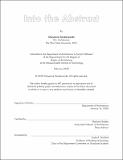| dc.contributor.advisor | Mariana Ibañez. | en_US |
| dc.contributor.author | Vandevoorde, Cheyenne(Cheyenne Jacqueline Louis) | en_US |
| dc.contributor.other | Massachusetts Institute of Technology. Department of Architecture. | en_US |
| dc.date.accessioned | 2021-02-19T20:21:08Z | |
| dc.date.available | 2021-02-19T20:21:08Z | |
| dc.date.copyright | 2020 | en_US |
| dc.date.issued | 2020 | en_US |
| dc.identifier.uri | https://hdl.handle.net/1721.1/129853 | |
| dc.description | Thesis: M. Arch., Massachusetts Institute of Technology, Department of Architecture, February, 2020 | en_US |
| dc.description | Cataloged from student-submitted thesis. | en_US |
| dc.description | Includes bibliographical references (pages 108-109). | en_US |
| dc.description.abstract | "Must we not then renounce the object altogether, throw it to the winds and instead lay bare the purely abstract?" - Vasily Kandinsky, 1911 Abstraction is a form of contemplation. It is a means to produce new, while honoring the essential. It advocates for expression and the non-determined. It is about opportunity. As such, abstraction has a prolific history that infiltrates most, if not all, forms of creative expression. The act of abstraction has grappled with the issues of representation, the objective and the narrative for the sake of something new. Either in Malevich's Black Square, Cage's 4'33" or Man Ray's Tears, abstraction has been used as a way to engage the zeitgeist and to radicalize our perception, thus propelling us forward. Through abstraction, form has an opportunity to produce a range of effects and emotional responses freed from semantics. Abstraction, instead of controlling the narrative, provides the chance to harness the power of the most essential aspects of a thing in order to prompt new readings and new expectations from our experience with the created world. Abstraction subverts the conventional method of arriving at the truth in an effort to perceive the truth through new perspectives. Into the Abstract questions the potential of abstraction as a method and its role in architecture. It seeks out to understand what an abstract method might be, how it can be used and what may be produced. This thesis is not about purism, minimalism, or reductivism. It is not about reduction or removal, but rather about "essentializing." This inquiry will take place on the sites of four distinct houses. Each will attempt its own approach to abstraction with results to be determined. | en_US |
| dc.description.statementofresponsibility | by Cheyenne Vandevoorde. | en_US |
| dc.format.extent | 109 pages | en_US |
| dc.language.iso | eng | en_US |
| dc.publisher | Massachusetts Institute of Technology | en_US |
| dc.rights | MIT theses may be protected by copyright. Please reuse MIT thesis content according to the MIT Libraries Permissions Policy, which is available through the URL provided. | en_US |
| dc.rights.uri | http://dspace.mit.edu/handle/1721.1/7582 | en_US |
| dc.subject | Architecture. | en_US |
| dc.title | Into the abstract | en_US |
| dc.type | Thesis | en_US |
| dc.description.degree | M. Arch. | en_US |
| dc.contributor.department | Massachusetts Institute of Technology. Department of Architecture | en_US |
| dc.identifier.oclc | 1237107929 | en_US |
| dc.description.collection | M.Arch. Massachusetts Institute of Technology, Department of Architecture | en_US |
| dspace.imported | 2021-02-19T20:20:38Z | en_US |
| mit.thesis.degree | Master | en_US |
| mit.thesis.department | Arch | en_US |
